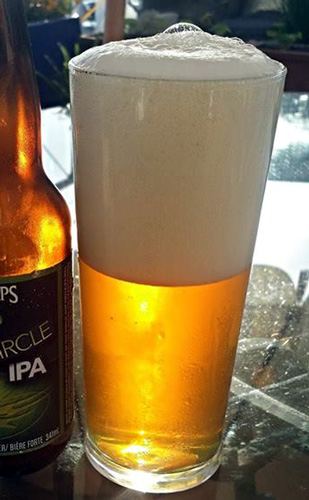File this one under ‘Oh lord, what now?’

If you’re having trouble guessing what the gadget is, don’t feel bad: other than the strange label (which makes it sound like it’s for shaving cream or perhaps for cartoon hedgehogs) there’s nothing about it that suggests a function. My first thought was that it was for rewinding DVD’s. However, according to the website,
Using ultrasonic vibrations, the Sonic Foamer excites the gases in your beer for an amazingly creamy head.
Oh. Okay. I can do the same thing by pouring the beer between two glasses, or stirring it with a spoon for a second, but sure, make an expensive gadget for stirring-impaired people, no problem. But why do they think you should stir it up and make a foamy head?
The aroma of a beer is released as the bubbles in the head pop.
No, that is not how the aroma in a beer is released. The aroma in a beer is released when the low-weight molecular compounds that comprise the bouquet and aroma of the beer travel from the liquid and travel through the air to the receptors in your nose. Bursting bubbles in the head aren’t especially relevant to the process.
Certainly, agitating the liquid helps increase the amount of these compounds released–that’s why wine tasters swirl their glasses. And beer judges do the very same thing, swirling sample glasses to chase out elusive aromas.

So it’s a gadget that’s a solution to a problem that exists in the minds of their marketing department. C’est la guerre. But even though their claims are malarkey, I can think of a brilliant use for one of these doohickeys: degassing excessively foamy beer.
This is a pet peeve of mine. Anyone who has gone on a pub crawl with me has had to watch me restlessly pour my beer between two glasses to chase off three-quarters of the carbon dioxide gas before I drink it. I don’t do it to all styles, because some styles like wheat beer, Kolsch and light lager need sufficient volumes of CO2 for proper mouthfeel.
‘Volume’ is the science-word for amount of gas in a liquid solution. The actual sciencey part of beer carbon dioxide saturation is governed by Henry’s Law and a bunch of frightening math. For our purposes, one volume of CO2 is the equivalent of one litre of carbon dioxide gas dissolved in one litre of beer at one atmosphere of pressure (sea-level, more-or-less). If you’re not metric, a litre is about a quart. If you’re having trouble conceptualising what this means, if you drink a litre of one-volume beer, you’re going to belch out one litre of burps, eventually.
A classic Czech Pilsner will have 2.3-2.5 volumes, very appropriate for that style, while Standard Western Industrial Light Lager will have 2.7+ volumes. That’s only fair since it doesn’t generally have any other character to speak of.
Where this all falls apart for me is ales. Classic British pale ales will have 0.75 to 1.3 volumes. If you’re a fan of these beers, they drink smooth and taste wonderful, and you don’t have to belch like a foghorn if you decide to have several pints. American ale styles on the other hand, have as much CO2 as lagers. American Pale Ale clocks in at up to 2.78 volumes, making the much heavier, more flavourful style of beer as gassy and belch-worthy as lawnmower S.W.I.L.L.

For my palate, this destroys the flavour, mouthfeel and enjoyability of the beer. CO2 gas in solution produces carbonic acid, a flat, bitter tasting substance which dulls the bright flavours in the beer, and it makes me feel bloated and belchy after only a couple of pints. I keep questioning brewers as to why they continue to overcarbonate their beer like it’s a practical joke drink but the standard reply is, ‘That’s what consumers expect’.

Some day I’m going to punch those consumers in the snoot, because they just don’t seem to know what’s good for them. If they tried the beer at a proper carbonation level they’d find it much more interesting and drinkable. Maybe some day. Until then I’ll have to content myself with making my own beer and carbonating it to the levels I like, degassing commercial beers right at the bar, and complaining about how everyone is wrong about everything except me.
But I’m thinking I need to order me one o’ those de-foamers to do a little testing . . .
